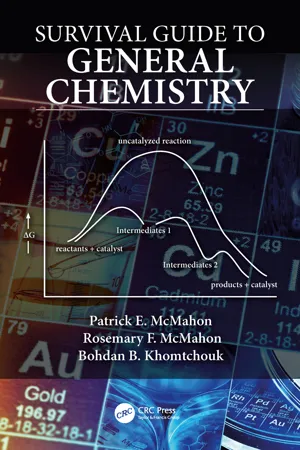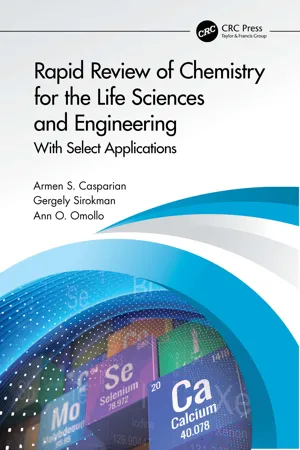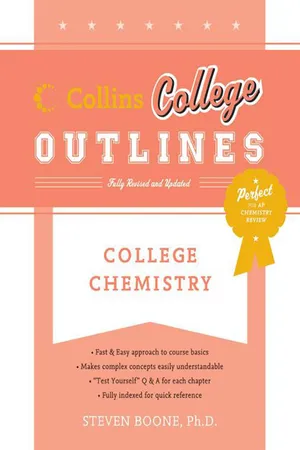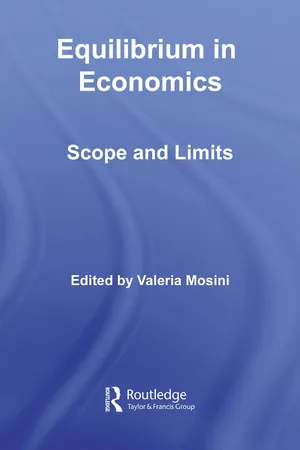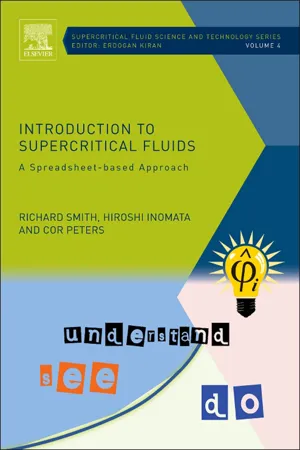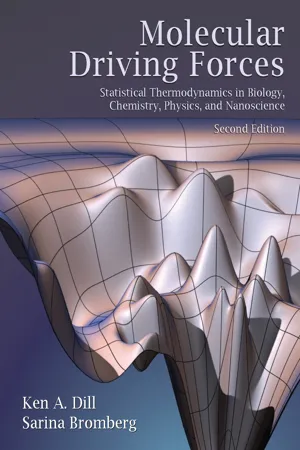Chemistry
Reaction Quotient and Le Chatelier's Principle
The reaction quotient is a measure of the relative concentrations of products and reactants at any point during a chemical reaction. Le Chatelier's Principle states that if a system at equilibrium is disturbed by a change in temperature, pressure, or concentration, the system will shift its position to counteract the disturbance and restore a new equilibrium.
Written by Perlego with AI-assistance
Related key terms
Related key terms
1 of 4
Related key terms
1 of 3
9 Key excerpts on "Reaction Quotient and Le Chatelier's Principle"
- eBook - ePub
- Jeffrey Gaffney, Nancy Marley(Authors)
- 2017(Publication Date)
- Elsevier(Publisher)
This is known as Le Chatelier's principle, after the nineteenth century chemist Henry-Louis Le Chatelier, who studied the effects of changes in reaction conditions on a chemical equilibrium. The exact statement of Le Chatelier's principle is; • When a chemical reaction at equilibrium is subjected to a change in reaction conditions, the position of the equilibrium will shift to counteract the effect of the change until a new equilibrium is established. The ways that a chemical reaction at equilibrium will respond when disturbed by a change in the original conditions can be predicted. These predicted responses and their effects on the equilibrium constant are summarized in Table 7.1 for each of the changing conditions. If the concentration of a reactant or product in a reversible chemical reaction at equilibrium is changed, by the addition or the removal of either a reactant or a product, the equilibrium will be reestablished by adjusting the concentrations of reactants and products so that their ratio and the value of K eq will remain the same. For example, if the concentration of reactant A in the generic Eq. (3) of Section 7.1 is increased by the addition of A to the reaction system, the reaction will shift to consume the added reactant A and form more of the products C and D. This increases the value of the numerator of K eq and decreases the value of the denominator compensating for the increase in the value of the denominator caused by the added reactant. This response can be useful in an industrial process if it is necessary to convert the maximum possible amount of reactant B into the products C and D when reactant B is an expensive or rare material and reactant A is inexpensive and abundant. In this case, the addition of excess reactant A becomes a means of conserving the more expensive reactant B while producing as much product as possible - eBook - ePub
- Patrick E. McMahon, Rosemary McMahon, Bohdan Khomtchouk(Authors)
- 2019(Publication Date)
- CRC Press(Publisher)
In this case, the concentrations of all reactants and products must change in order to re-establish the required equilibrium ratios. The outside changes may be an addition or removal of some of the moles of a reactant or product; this will then change the concentration of the compound added or removed and, thus, temporarily will change the [product] to [reactant] ratio. The outside change may be an addition (temperature increase) or removal (temperature decrease) of some heat. Heat can be considered a product or reactant based on the sign of the enthalpy (ΔH). A change in temperature results in the change of the heat product or reactant and will also produce a temporary change in the actual concentrations described by the [product] to [reactant] ratio. Le Chatelier’s principle states that if an additional outside change is induced on an established equilibrium reaction, the reaction will respond by attempting to counteract the outside change. (1) If reactants are added to or products are removed from an equilibrium, the forward reaction increases its rate to convert some of the reactant molecules to product molecules; the result is to remove some of the extra reactant molecules or replace some of the depleted product molecules. This response decreases the concentration of the reactants, increases the concentration of product molecules, and, thus, reestablishes the original required equilibrium ratio. If the rate of the forward reaction must increase, the reaction is said to shift to the right or to shift toward products. (2) If reactants are removed from or products are added to an equilibrium, the reverse reaction increases its rate to convert some of the product molecules to reactant molecules; the result is to remove some of the extra product molecules or replace some of the depleted reactant molecules - eBook - ePub
Rapid Review of Chemistry for the Life Sciences and Engineering
With Select Applications
- Armen S. Casparian, Gergely Sirokman, Ann Omollo(Authors)
- 2021(Publication Date)
- CRC Press(Publisher)
Le Chatelier’s Principle, which states: If a stress is imposed on a reaction at equilibrium, the reaction will shift either right or left in the way or direction that accommodates or relieves the stress.There are five categories of stress:- The reactant concentration or product concentration is increased or decreased.
- The temperature of the reaction is increased or decreased.
- The volume of the reaction vessel is increased or decreased.
- The pressure of the reaction is increased or decreased (in any one of three different ways).
- A catalyst is added to the reaction.
Example 4.6: (A–F) Stresses and LeChatelier’s Principle Consider the following reaction already at equilibrium:CS 2( g )+ 3Cl 2( g )⇌S 2Cl 2( g )+CCl 4( g )The enthalpy or heat of reaction is ΔH° = −84.3 kJ.Predict what will happen—increase, decrease, or no change—to the equilibrium concentration of CCl4 when each of the following stresses is imposed:- Cl2 is added.
- S2 Cl2 is removed.
- The temperature is increased.
- The volume of the reaction vessel is decreased.
- The pressure is decreased by increasing the volume of the reaction vessel.
- A catalyst is added.
SolutionUse Le Chatelier’s Principle to answer each part.- Adding Cl2 will cause the reaction to shift to the right, increasing [CCl4 ].
- Removing S2 Cl2 will cause the reaction to shift to the right, increasing [CCl4 ].
- To answer this part, the meaning of ΔH° must be understood. This is the amount of heat energy either liberated or absorbed in the reaction and may be expressed in either kilojoules (kJ) or kilocalories (kcal). If heat energy is liberated, the reaction is exothermic, and the sign of ΔH is negative by convention. If heat energy is absorbed, the reaction is endothermic, and the sign of ΔH is positive. Here, the sign is negative, so heat is produced. Hence, since raising the temperature adds heat and heat behaves as a product, increasing the temperature will shift the reaction to the left, decreasing [CCl4
- Mark Kernion, Joseph A. Mascetta(Authors)
- 2021(Publication Date)
- Barrons Educational Services(Publisher)
A change in pressure affects only equilibria in which a gas or gases are reactants or products. Le Châtelier’s Principle can be used to predict the direction of displacement. If it is assumed that the total space in which the reaction occurs is constant, the pressure will depend on the total number of molecules in that space. An increase in the number of molecules will increase pressure; a decrease in the number of molecules will decrease pressure. If the pressure is increased, the reaction that will be favored is the one that will lower the pressure, that is, decrease the number of molecules.An example of the application of these principles is the Haber process of making ammonia. The reaction isN2 + 3H2 ⇌ 2NH3 + heat (at equilibrium)If the concentrations of the nitrogen and hydrogen are increased, the forward reaction is increased. At the same time, if the ammonia produced is removed by dissolving it in water, the forward reaction is again favored.Since the reaction is exothermic, the addition of heat must be considered with care. Increasing the temperature causes an increase in molecular motion and collisions, thus allowing the product to form more readily. At the same time, the equilibrium equation shows that the reverse reaction is favored by the increased temperature, and so a compromise temperature of about 500°C is used to get the best yield.An increase in pressure will cause the forward reaction to be favored since the equation shows that four molecules of reactants form two molecules of products. This effect tends to reduce the increase in pressure by the formation of more ammonia.Equilibria in Heterogeneous Systems
The examples so far have been of systems made up of only gaseous substances. The expression of the Keq of systems is changed with the presence of other phases.EQUILIBRIUM CONSTANT FOR SYSTEMS INVOLVING SOLIDS
If the experimental data for this reaction are studied:CaCO3 (s) ⇌ CaO(s) + CO2 (g)it is found that at a given temperature an equilibrium is established in which the concentration of CO2 is constant. It is also true that the concentrations of the solids have no effect on the CO2 concentration as long as both solids are present. Therefore, the Keq- No longer available |Learn more
- Steven Boone, Drew H. Wolfe(Authors)
- 2011(Publication Date)
- Collins Reference(Publisher)
CHAPTER 15Introduction to Chemical Equilibria
Chemical equilibrium systems are more resistant to change than those that are not in equilibrium. When an equilibrium system is disturbed, it responds in order to reestablish a state of equilibrium.15.1 THE EQUILIBRIUM STATEChemical reactions proceed spontaneously until they reach a state of dynamic equilibrium. At equilibrium, the rate of the forward reaction equals the rate of the reverse reaction. At this point, the reactant and product concentrations remain constant.Forward and Reverse ReactionsArrows that point in opposite directions, , show that an equilibrium has established. For example, the following equation is written for the equilibrium of H2 and CO2 with CO and H2 O.H2 (g) + CO2 (g) CO(g) + H2 O(g)The reaction that goes from left to right is the forward reaction, and the reaction that goes from right to left is the reverse reaction. Establishing Equilibrium Consider the following model reaction as it establishes equilibrium.H2 (g) + CO2 (g) → CO(g) + H2 O(g)When H2 and CO2 mix at constant temperature in a reaction vessel, they combine and begin to form the products, CO and H2 O. Hence, the concentrations of H2 and CO2 decrease, and the concentrations of CO and H2 O increase. As the reactant concentrations decrease, the rate of the forward reaction decreases and the rate of the reverse reaction increases. At some point, the rate of the forward reaction equals the rate of the reverse reaction and a chemical equilibrium establishes. After this time, the concentrations of the reactants and products do not change.The Equilibrium Constant ExpressionAn important quantitative relationship exists between the concentrations of the reactants and products. This relationship was identified by Cato Maxmilian Guldberg and Peter Waage in 1864 when they proposed the Law of Mass Action that expresses the equilibrium concentrations of the reactants and products in terms of an equilibrium constant expression (equilibrium expression - eBook - ePub
- Adrian Dingle, Derrick C. Wood(Authors)
- 2014(Publication Date)
- Research & Education Association(Publisher)
, molefraction of . Then, partial pressure of N2 O4 = (0.333)(3.0 atm) = 1.0 atm and partial pressure of NO2 = (0.666)(3.0 atm) = 2.0 atm.Passage contains an image
Chapter 24
Le Chatelier’s Principle
I. Le Chatelier’s PrincipleA. Le Chatelier’s Principle states that a change in the factors that govern the chemical equilibrium of a system will cause the system to respond in a manner that counteracts the change, i.e., to bring whatever has been changed by the stress (Q—the reaction quotient, or K—the equilibrium constant) back into equality with one another.1. Chemical equilibrium can be disrupted in different ways.i. Change in temperatureii. Change in concentration of reactant or productiii. Change in volume or pressure (where gases are involved)Note: Catalysts do not affect the equilibrium position, only the speed at which it is achieved.2. Effect of temperature (will affect the value of K)Onlya temperature change will result in a change of the value of K. This is a common “trick” question. Other changes may cause there to be more reactants or products, i.e., they will affect Q, but if temperature is constant, then K is constant. The equilibrium will always shift in order to bring Q and K back into equality with one another. - eBook - ePub
- Valeria Mosini(Author)
- 2008(Publication Date)
- Routledge(Publisher)
And since quadratic forms of this type are intimately involved in economic maximising problems, it is not surprising that the Le Chatelier principle should have found many applications in theoretical economics’ (Samuelson 1960b, p. 368). 20 In the same paper, Samuelson stated that the mathematical isomorphism between thermodynamics and mathematical economics creates an analogy between the two disciplines that would not be challenged even by the possible failure to find analogies between the parameters – which reflect the properties of the entities – that appear in the theories (Samuelson 1960b). As this, and other, similar, considerations suggest, Samuelson was reasoning about ‘abstract’ mathematical analogies, 21 thereby showing that the Le Chatelier–Samuelson principle was born out of the deductive methodology. Conclusion We wish to conclude by pointing out some common aspects between the epistemologies underlying the two concepts of equilibrium outlined here. Lavoisier and Le Chatelier were concerned, one might say obsessed, with rationalisation. Ratio means rapport, quantification, mathematisation. Both men had a deep faith in mathematics, and used the concept of equilibrium to quantify chemical reactions. Lavoisier’s all-pervasive balance method relied on the assumption that matter is conserved, an assumption that provided him with a means of universal commensurability. On his account, all sorts of phenomena – oxidation, the work of an artist, the growth of a plant – could be compared by means of weighing. Even an imponderable substance such as caloric could be ‘weighed’, as it were, by the use of a calorimeter. Le Chatelier’s concept of equilibrium was haunted by the acknowledgement of the inevitability of losses in physical processes, sanctioned by the second principle of thermodynamics - eBook - ePub
Introduction to Supercritical Fluids
A Spreadsheet-based Approach
- Richard Smith, Hiroshi Inomata, Cor Peters(Authors)
- 2013(Publication Date)
- Elsevier Science(Publisher)
Chapter 9Chemical Equilibria and Reaction Kinetics
Richard Smith, Cor Peters and Hiroshi Inomata Logic will get you from A to B. Imagination will take you everywhere. Albert Einstein (1879–1955)Tip Box#1 Chapter objectives(1) to review key concepts in thermochemistry (2) to introduce methods for analyzing chemical equilibria (3) to show the effect of nonidealities on “real world” chemical equilibria (4) to introduce thermodynamic analysis of chemical reactors (5) to show how reaction kinetics are used to model reaction pathways9.1 Overview
Chemical equilibria gives one the composition of a reaction system in its most stable state, whereas reaction kinetics gives one the rate at which the chemical species are transformed from their initial state to a final state. Analysis of chemical equilibria helps one to understand the limits of a reaction according to its thermodynamics and the given reaction conditions. Analysis of reaction kinetics helps one to understand how long it will take to make the transformation in reality. Detailed development of chemical equilibria theory is given in many excellent undergraduate textbooks in chemical thermodynamics [CT1 –CT3] and chemical reactions [CT4] .With any type of chemical reaction or process, energy transfer occurs and this is the basis of thermochemistry. The energy transfer of a reaction is described by thermochemical equations, which are balanced stoichiometric equations for the reactant and product chemical compounds. Thermochemical equations are written in terms of the moles of each chemical compound, for example:(9.1)The a and b are stoichiometric coefficients that represent the moles of reactant chemical compounds A and B , respectively, required to form c moles of product chemical compound C . When changes in properties are calculated by treating Eq. (9.1) as a mathematical equation, by convention, the stoichiometric coefficients are positive (+) for products and negative (−) for reactants . Thus, the change in enthalpy of Eq. (9.1) - eBook - ePub
Molecular Driving Forces
Statistical Thermodynamics in Biology, Chemistry, Physics, and Nanoscience
- Ken Dill, Sarina Bromberg(Authors)
- 2010(Publication Date)
- Garland Science(Publisher)
A. You can point the arrow in either direction. Once you choose the direction, the sign of every thermodynamic quantity is determined.The quantity that predicts chemical equilibria is the chemical potential. A chemical potential represents the tendency of a molecule or particle to move or convert or escape from the state it is in. For equilibria at fixed temperature and pressure, the appropriate extremum function is the Gibbs free energy: dG = −S dT + V dp + μA dNA + μB dNB , where NA and NB are the numbers of particles in the two states and μA and μB are their chemical potentials. At constant T and p, the condition for equilibrium isd G =μ AdN A+μ BdN B= 0.(13.2) If every molecule is in either state A or B, the total number of molecules Ntotal is constant:N A+N B=N total= constant ⇒ dN A+ dN B= 0.(13.3) A molecule lost as A is converted to B, so dNA = −dNB , and the condition for equilibrium, Equation (13.2) , can be written in terms of dNA :(d)μ A−μ BN A= 0.(13.4) Equation (13.4) must hold for any nonzero variation dNA , so the condition for equilibrium is that the chemical potentials of species A and B are the same:
To proceed further, we need to relate each chemical potential to its partition function. Partition Functions for Chemical Reactionsμ A=μ B.(13.5) First, express the partition function, Equation (10.19) , in terms of q′, where the added ′ indicates that we include the ground state explicitly:q ′=.∑j = 0te=−/ε jk Te+−/ε 0k Te+ ⋯ +−/ε 1k Te−/ε tk T(13.6) We need to retain the ground-state terms for chemical equilibria because the species A and B do not necessarily have the same ground states. Now we redefine q
Index pages curate the most relevant extracts from our library of academic textbooks. They’ve been created using an in-house natural language model (NLM), each adding context and meaning to key research topics.
Explore more topic indexes
Explore more topic indexes
1 of 6
Explore more topic indexes
1 of 4

